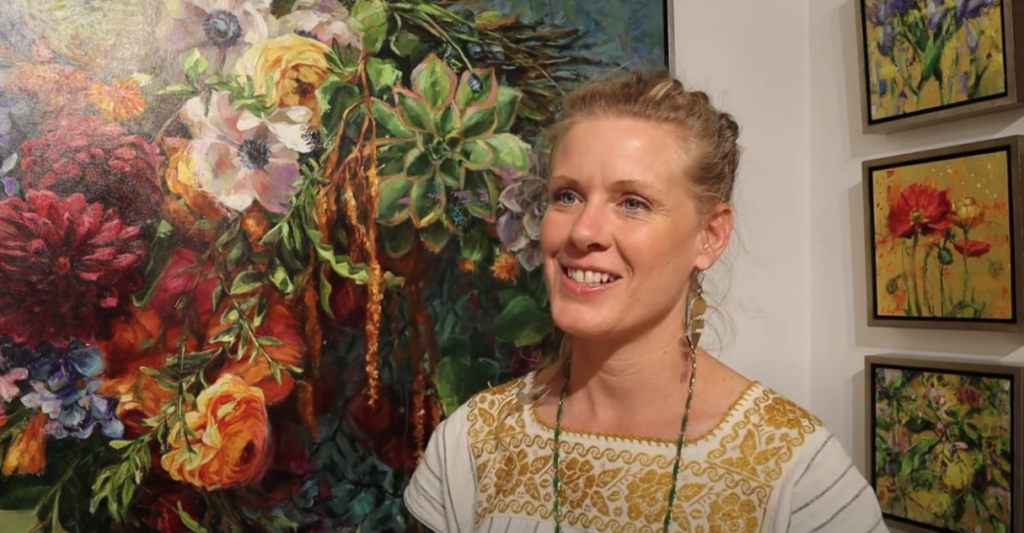
Elizabeth Butler’s oil paintings, which often depict floral scapes, are absolutely breathtaking. But beyond the vibrant color palette and beauty that emanates from these pieces, there’s a deeper story––one of transformation, self expression, and coming home.
Initially, painting was a way for Elizabeth to find stillness amid the chaos of life. It was an outlet and an opportunity to do some inner exploration, but she hadn’t considered it as a potential career until she realized how much joy it brought her. From that point forward she determined to build her life around it.
Today, her art continues to serve as a powerful source of self exploration for Elizabeth. The process of creating each piece takes her on a transformative journey as she focuses on being as open and vulnerable as possible. This approach results in mesmerizing artwork that is not only rich in color and texture, but also in experience. Though Elizabeth goes on a personal journey with each piece, her hope is that the viewer also goes on their own individual journey––one that’s personal to them.
Elizabeth’s work is a beautiful bridge between traditional representations and a deep pull to the present moment.
Read on or watch the video below to learn more about how Elizabeth connects these worlds.
When did you know art was your calling?
I was always interested in art, but it wasn’t something I considered as a career. It was something that became more important to me as I placed greater priority on self-expression and living to my fullest. It’s what I realized was bringing me more and more joy. So I made a decision to create my life around my art no matter what.
What do you love most about creating art?
I love the internal journey that it takes me on. I love the challenge of being as open as possible to my own inner knowing and what wants to come through, which sometimes is a little scary. You have to be really vulnerable and nonjudgmental of whatever is taking place in the internal realm.
What challenges you the most about your work?
Recently I’ve been focusing a lot on coming to a place of non-attachment and no aversion. That can be quite challenging because there is a lot of identification that we can make with what we produce. Sometimes what we’re making has a purpose deeper and beyond our own ego and even further than self expression. For me to be fully open to that, I have to work on letting go of an attachment either to something that I think is really beautiful that I don’t want to change or an aversion to something that I think doesn’t look correct or seems out of place. Both of those are judgments from the mind as opposed to feeling from the heart whatever wants to be expressed and accepting and embracing it as it is, knowing that it’s a transformative journey that’s continually evolving and changing. Any attachment to a moment in time interrupts the openness and the transformative process that art is.
What do you hope your work inspires in others?
What I hope other people experience is some sense of coming home––a sense of belonging, a sense of joy, a sense of beauty. A connection that is nonverbal, but very experiential because the process is a very experiential one for me. When people ask me about my favorite piece, I don’t think of the piece, but I think of the experience of making it. What I hope somebody has is an experience that’s personal to them and not one that I’m dictating, but one that they’re experiencing beyond the mind.
How has your work evolved?
I was trained in a really academic and technical way, which has been a beautiful gift. It allows me to make whatever I want to make but there’s also an aspect of self-expression that has become much more important to me in the past years for allowing that to come into my work so that there’s more expressiveness and creativity. I know everything we do is creative, but I’m excited to see what else paint can do that it hasn’t done and how else I can combine things.
I’ve noticed that I’m more interested now in the different ways that paint can move across the surface, as opposed to just representing what can be seen. I’d like to represent things that we might feel are there that we don’t necessarily initially see in this three-dimensional reality.
What drew you to the Celebration of Fine Art?
Most of my time is spent alone in my studio, which I love. This experience is unique because the people are here to receive you and experience your work with you. That allows me to participate more in other people’s experience of my work, which makes me think about different directions that I might want to go or how I want to evolve or just be surprised by things that I didn’t expect to hit people in a certain way.

